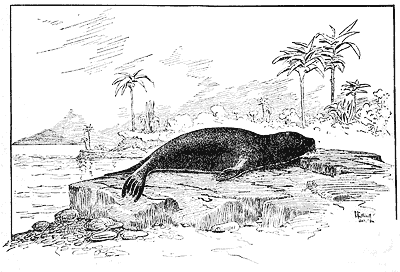 |
|
|
 |
||
Gail Swanson The last sighting of the seal at the Keys was at Key West in 1922, and that animal was shot. The last known sighting in the world was in 1952 on Serranilla Bank in the western Caribbean. Wildlife biologist Karl W. Kenyon carried out a 4,000-mile aerial search for the seal in 1973, and wrote in May 1980: "My reluctant conclusion is that the Caribbean Monk Seal became extinct soon after the last one was observed in 1952" (Kenyon 1980). Columbus’ men, on his second voyage, were the first to record the seal’s existence. They killed a herd of eight in August, 1494, at an island just south of Haiti. Called "sea wolves" by the Spanish, they were recorded at the Keys first by Ponce de Leon in his 1513 voyage. Based on original papers which have since been lost, Spanish historian Herrera wrote 90 years later on his voyage: "…they ran on the same course, until Tuesday the 21st, when they reached the isleos, which they named Las Tortugas, because in one period of the night they took on one of these islands 160 turtles, and might have taken many more if they wished, and also they took 14 lobos marinos [sea wolves], and killed many gannets, and other birds…" (Kelley 1991). The next record of the seals at the Keys was written by Hernando d’Escalante Fontaneda, shipwrecked at the Keys in 1549 (Swanson 1999). He wrote of the Indian people that "Some eat sea wolves; not all of them, for there is a distinction between the higher and the lower classes, but the principal persons eat them" (Fontaneda 1944). For a larger regional record, to the north of the Keys a seal jaw has been found in an Indian shell mound on the mainland near Lake Helen Blazes (Neill 1957). Dog Rocks, so named by the Spanish (Cayo Lobos), south of the Keys, may be named after the seals, and to the east of the Keys there is at least one Bahamian record from the early 1700s. The historian Hans Sloan was quoted by Peter M. Knudtson in his article The Case of the Missing Monk Seal: "The Bahamas are filled with seals; sometimes fishers will catch one hundred in a night. They try or melt them and bring off their oil for lamps to these islands" (Neill 1957, Knudtson 1977). Back to the Keys. Keys resident Louise White found monk seal bones in her search of lower Keys Indian sites; her collection is now at the Tropical Crane Point Hammock Museum in Marathon, Key Vaca. And archaeologist Robert S. Carr has found monk seal bones at the Cuchiaga Indian site on Stock Island. In 1742 a British warship named H.M.S. Tyger was wrecked at the Dry Tortugas and her crew of over 200 men were marooned on the islets for 63 days. The ship’s log, brought ashore, records almost daily capture of seals for men to eat (Public Record Office, London 1742). In a 1763 report of Florida by William Roberts, it is written that "On La Sonda [the sound], north of the [Dry] Tortugas, there is a very good fishery...it also abounds with great plenty of seals, the fat of which the Spaniards pay [coat] the bottom of the ships with at the Havana" (Roberts 1763). Most closely related to the seals of the Antarctic, it is a mystery how the tropical seal came to be; the others of the family are far away from the Caribbean: the Mediterranean monk seal and the Hawaiian monk seal. They still maintain a small foothold in the world, one that our monk seal lost due to European man’s arrival in the New World. Fontaneda, Hernando d'Escalante. 1854. Letter of Hernando de Soto, and Memoir of Hernando de Escalante Fontaneda. Translated and published by Buckingham Smith, 1854. Patronato 18, numero 5, AGI (Archivo Generale de Indies). Kenyon, Karl W. 1980. No man is benign. The endangered monk deal. Oceans 3: 48-53. Kelley, James E. 1991. Juan Ponce de Leon's Discovery of Florida: Herrera's Narrative Revisited. Revista de Historia de America, Enero-Junio (1991): 46-47. Knudtson, P.M. 1977. The case of the missing monk seal. Natural History 86: 78-83. Neill, Wilfred T. 1957. The Vanished Sea Wolves. Florida Wildlife, January 1957: 16-17; 38. Public Record Office, London. 1742. ADM 1/5276. Court Martial of Capt. Edward Herbert for the loss of H.M.S. Tyger. (The log is filed with documents relating to the court martial of Edward Herbert for the loss of the Tyger. It has been transcribed by Cudjoe Key resident John Viele and is now a part of the State and Local History Collection of the Monroe County Public Library at Key West, Florida.) Roberts, William. 1763. An Account of the First Discovery, and Natural History of Florida. Reprinted 1976. University of Florida Press, Gainesville, USA: 1-117. Swanson, Gail. 1999. The Florida Keys 450 Years Ago: Fontaneda’s Memoir. Edited by Gail Swanson. History Talk from the Upper Florida Keys, Fall (1999): 134-136.
THE CARIBBEAN MONK SEAL
Imagine 6 to 9 foot, 500 pound seals basking on the sunny beaches of the Florida Keys. We can only imagine, for the seal that did inhabit Keys waters since the islands were formed from a reef is now extinct. The last century was the final one for the tropical seal of the Bahamas, south Florida, Caribbean Islands and Gulf of Mexico. Exploited by European man, the 15-million-year-old seal has just lived its final millennium.
The Caribbean monk seal Monachus tropicalis as depicted by Henry W. Elliott in 1884
Sources
Gail Swanson’s article was originally published in the Winter 99/2000 issue of History Talk from the Upper Florida Keys.
Copyright © 2000 Gail Swanson, The Monachus Guardian. All Rights Reserved